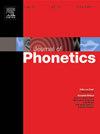Advancements of phonetics in the 21st century: Phonetic universals, language variation, and phonetic grammar
IF 2.4
1区 文学
0 LANGUAGE & LINGUISTICS
引用次数: 0
Abstract
This review, part of the journal’s special collection on Advancements of Phonetics in the 21st Century, examines the interplay between phonetic universals and language variation at both segmental and utterance levels. It traces the physiological and biomechanical foundations of phonetic universals established by 20th-century research while focusing on cross-linguistic variation explored predominantly in 21st-century research. Segmental phonetic universals include the role of the syllable in organizing segments and gestures, intrinsic vowel duration influenced by vowel height, extrinsic vowel duration due to coda voicing, intrinsic and co-intrinsic f0 variation affected by vowel height and onset consonant characteristics, respectively, and place effects on closure duration and VOT. While segmental universals stem from distinct mechanical bases, utterance-level universals emerge from respiratory and articulatory resets at utterance onset, shaping the entire speech production system—a perspective substantiated here based primarily on 21st-century phonetic research. These resets structure prosodic organization, leading to weakening effects at the right edge (e.g., f0 declination, articulatory declination, phrase-final lengthening) and strengthening effects at the left edge (e.g., domain-initial strengthening) and occasionally at the right edge as well (e.g., phrase-final strengthening) when sufficient time permits. Extensive evidence demonstrates that phonetic universals are further shaped by language-specific factors and the interaction between system-oriented and output-oriented constraints. This diversity calls for detailed phonetic descriptions tailored to each language, with phonetic grammar, as proposed here, fine-tuning phonetic realization accordingly. Research in the 21st century has also illuminated that segmental and utterance-level universals, traditionally regarded as distinct, are deeply interconnected, if not inseparable. The Extended Model of Phonetic Grammar is introduced as a framework for mediating this relationship within the phonetics-prosody interface as well as interactions with other higher-order linguistic structures. Furthermore, language variation within phonetic universals suggests that many phonetic processes, once considered automatic, are actively controlled by speakers, reflecting the unique evolutionary pathways of different languages.
21世纪的语音学进展:语音共性、语言变异与语音语法
这篇评论是《21世纪语音学进展》杂志特辑的一部分,研究了语音共性和语言变化在分段和话语水平上的相互作用。它追溯了20世纪研究建立的语音共性的生理和生物力学基础,同时重点关注21世纪研究中主要探索的跨语言变异。音段语音共性包括音节在组织音段和手势中的作用、受元音高度影响的固有元音时长、受尾音影响的外在元音时长、分别受元音高度和起始辅音特征影响的固有和共固有f0变化,以及位置对闭合时长和VOT的影响。虽然片段共相源于不同的机械基础,但话语层面的共相来自于话语开始时的呼吸和发音重置,塑造了整个语音产生系统——这一观点主要基于21世纪的语音研究。这些重置了韵律组织的结构,导致右边缘的减弱效应(例如,f0偏音,发音偏音,短语-结尾延长)和左边缘的强化效应(例如,域初始强化),并且在足够的时间允许时偶尔也会在右边缘(例如,短语-结尾强化)。大量证据表明,语音共性进一步受到语言特定因素以及系统导向和输出导向约束之间的相互作用的影响。这种多样性要求为每种语言量身定制详细的语音描述,并根据这里提出的语音语法对语音实现进行微调。21世纪的研究也表明,传统上被认为是截然不同的语段共相和话语共相,即使不是不可分割的,也是紧密相连的。语音语法扩展模型作为一个框架被引入,用于在语音-韵律界面以及与其他高阶语言结构的交互中调解这种关系。此外,语音共性中的语言变异表明,许多语音过程曾经被认为是自动的,但实际上是由说话者主动控制的,这反映了不同语言的独特进化途径。
本文章由计算机程序翻译,如有差异,请以英文原文为准。
求助全文
约1分钟内获得全文
求助全文
来源期刊

Journal of Phonetics
Multiple-
CiteScore
3.50
自引率
26.30%
发文量
49
期刊介绍:
The Journal of Phonetics publishes papers of an experimental or theoretical nature that deal with phonetic aspects of language and linguistic communication processes. Papers dealing with technological and/or pathological topics, or papers of an interdisciplinary nature are also suitable, provided that linguistic-phonetic principles underlie the work reported. Regular articles, review articles, and letters to the editor are published. Themed issues are also published, devoted entirely to a specific subject of interest within the field of phonetics.
 求助内容:
求助内容: 应助结果提醒方式:
应助结果提醒方式:


